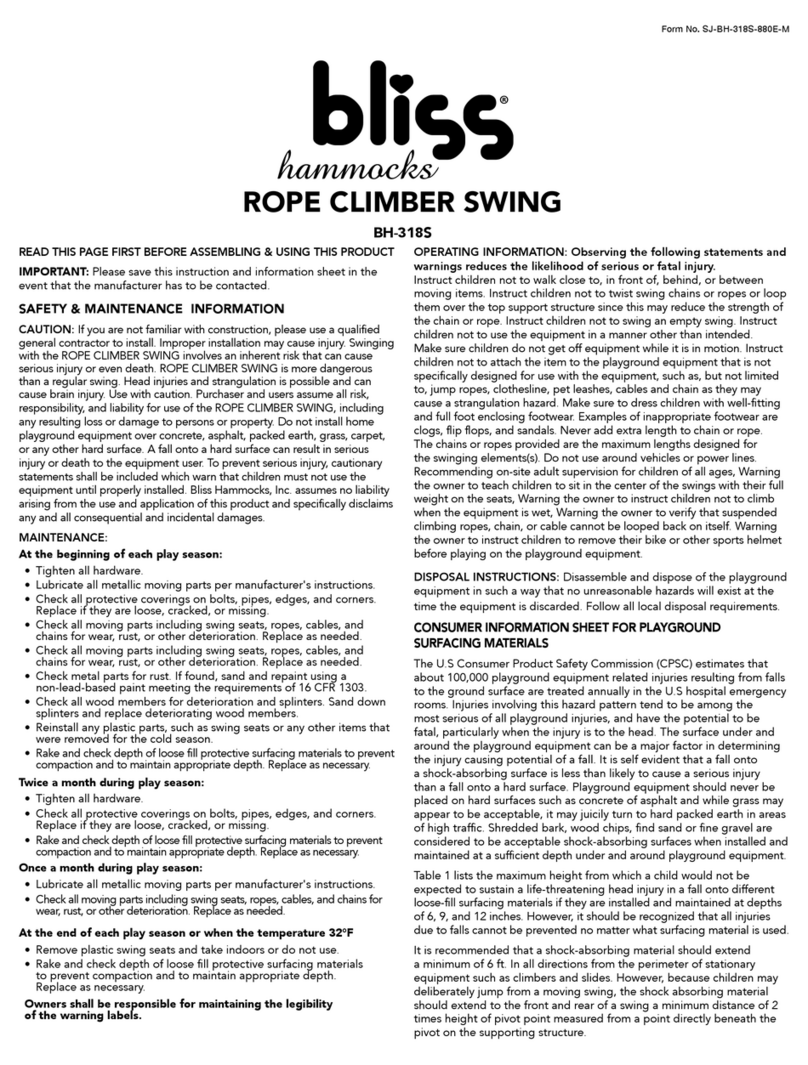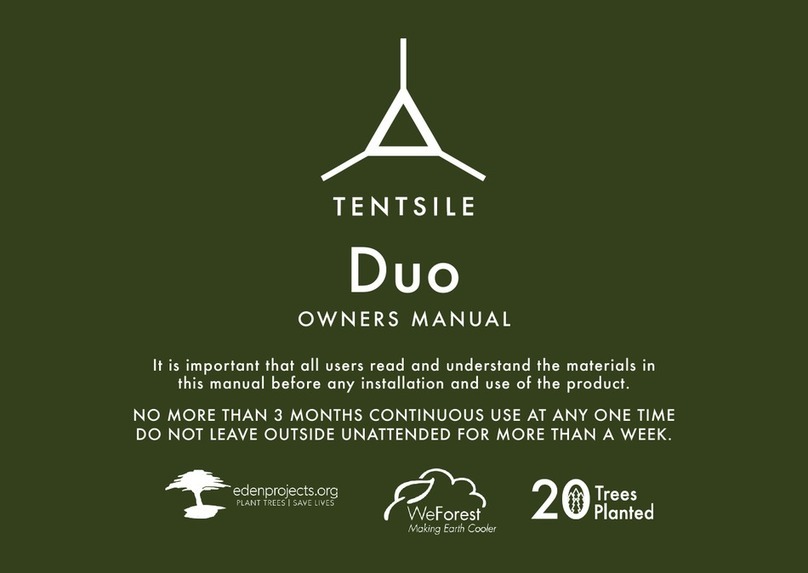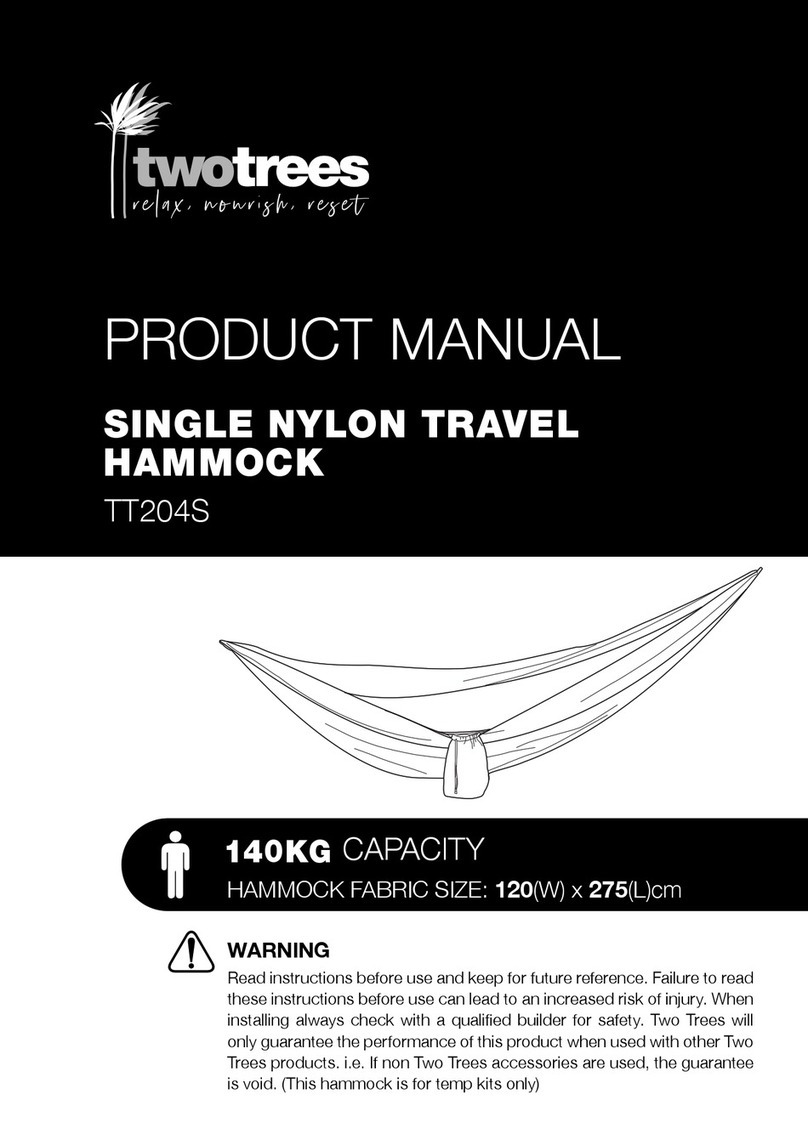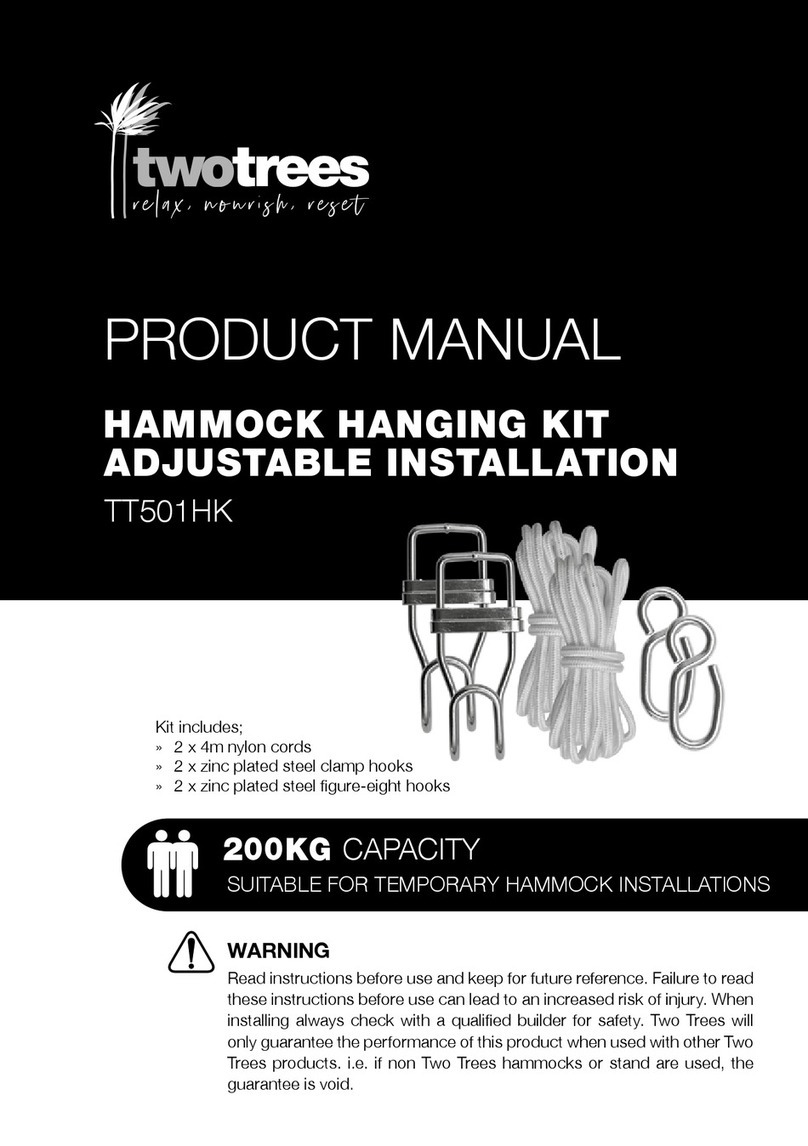Tensa Outdoor Trekking Treez User manual

Tensa Trekking Treez
v2.0 - ‘Svelte’
User Guide
Description................................................................................................2
Getting started ..........................................................................................2
Trekking mode ..........................................................................................3
Hammock mode .......................................................................................4
Specifications ............................................................................................7

Description
Tensa Trekking Treez are trekking poles that convert to a hammock stand, allowing
backpackers to sleep in hammocks instead of on the ground in alpine, desert, or similar
tree-sparse areas. We sell poles and related accessories singly as systems to support one
side of a hammock,since having only one with an available tree greatly increases
hammock-eligible sites even in wooded areas. Two systems form a complete stand and
pair of trekking poles.Trekking Treez, used as replacements for standard trekking poles,
remove the need for redundant ground sleeping gear, saving weight while preserving the
superior comfort of hammock camping.
Getting started
Familiarize yourself with all parts. Each system includes:
1. Handle, top
knob, Hubz,
and strap
2. Adjuster
3. Coupler
4. Extension
5. Trekking
foot / tarp
extension
6. Hammock
foot
7. 2 guylines
8. 2 anchors,
assorted
9. Storage bag
10. Snow basket & rubber tip
2
2
4
6
8
7
3
5
1
9
10

Trekking mode
Choose whichever assembly provides the desired range of pole height adjustment.
Shorter hikers tend to prefer the handle, adjuster, coupler, and trekking foot. Taller users
will insert the extension between the coupler and trekking foot. Always sink the handle at
least four inches (10cm) into the flip lock adjuster. Pack all remaining components until
time to set up in hammock mode.
When joining segments with internal threading, do not over-
tighten.Snug enough to prevent loosening in use is sufficient. Do not
over-tighten the flip lock adjuster nut. If you must loosen it to make
height changes,then it is too tight.
Trekking pole use permits many styles. Most prefer a height that
allows for forearm to be parallel to the ground when the strap is
loose. Let the strap bear your weight so you needn’t grip the handle
tightly, to minimize fatigue. A two-finger grip toward the bottom of
the handle provides a lower swing weight, improves balance, and
allows for a quick choke up on the grip or to the top knob in palm to
extend the effective pole length for brief descents, without having to
adjust the flip lock.
The rubber tip is meant mainly to protect the bag, your tarp, and
items in your pack from the hard carbide tip of the trekking foot. As a
walking tip, it is easily worn or lost. Both rubber and carbide tips, as
well as snow baskets, are non-proprietary consumable items, with
replacements available from many sources.
You may replace the trekking foot with the hammock foot if you
prefer a blunt tip for use on soft surfaces.This also allows for use in
the mode of a taller hiking staff. Note that hiking with the hammock
foot on hard surfaces may result in rapid wear. Replacing the
hammock foot requires returning to Tensa Outdoor or some level of
home tooling and skill.
The aluminum Hubz piece below the top knob secures the strap, but it may be stored
separately, with the threaded post under the knob serving to retain the provided or
alternate straps when the knob is tightened to pinch them. The post beneath the top
knob is threaded like that of camera tripod mounts.You can use the pole as a monopod.
3
Coupler
Adjuster
Handle
Trekking foot

Hammock mode
Site selection
Site selection is probably the single most important element of
successful hammocking with Trekking Treez (TT). Using both poles,
the total footprint of a TT hang can exceed 25´×6´ (7.5 ×1.8m.)
Select accordingly, though the site needn’t be level, and the
guylines may pass through brush.
Just as hikers who sleep on the ground keep hiking until they find
reasonably level, dry sites free of rocky or woody bumps, so TT users
search for ground conditions that will reliably hold the anchors, or
feature alternative guyline anchoring points such as woody shrubs,
exposed roots,or certain rock profiles.
Avoid sites whose soil, sand or gravel is loose, does not form firm
clumps, lacks reinforcing root structures, features semi-liquid mud,
or is too shallow before rock prevents sinking the anchors. In
challenging environments, it's wise to stop early to test sites before
nightfall brings urgency.
A single healthy tree,pole,or rock feature able to support one side
of your hammock doubles your chances of success while halving
the labor of setting up. Even trees unsuitable for hanging often
have root systems much larger than their canopies,helping assure
that adjacent ground anchors will hold.
Assembly
Screw all segments together, with the hammock foot at the
bottom,and, if using a tarp, with the inverted trekking tip replacing
the top knob. Use the rubber tip to protect the tarp from the sharp
trekking tip. Important: collapse the handle into the flip-lock
adjuster completely before hanging the hammock, as the flip lock
can't bear hammock loads. Remove and store the top knob and
trekking strap safe from salt-loving animals.
See the fully assembled hammock-mode pole to the right. An
alternative use of the poles is as tarp supports, each able to exceed
six feet (1.8m).
4
Hammock foot
Extension
Coupler
Adjuster
Handle
Tarp extension

Setup
1. Lay both poles out on the ground in a straight line, top tip to top tip. Your hammock
will follow this line.
2. Attach the black loops of the guylines to the pairs of Hubz hooks that are closest to
one another. Extend the guylines, let out to their longest adjustment, so their ends
are roughly 6´(1.8m) apart,centered on the pole as shown:
3. Drive in the ground anchors at the ends of the guylines, and attach the guylines.
4. Stand up the poles leaning toward each other, and attach the hammock to the
remaining pair of Hubz hooks. Hubz are designed to receive 7/64˝ Amsteel cordage. If
your hammock lacks similar, we suggest you fashion adapter loops of Amsteel to fit.
5. Tension all guylines and the hammock ridgeline by pulling the orange lines through
the black constrictors, then milking the buries to set. Milking the bury means
pinching the black constrictors through which the orange lines pass,and sliding
down to elongate, removing slack. Sliding the constrictors up will release to loosen.
Tip: when tightening,loop the orange tails up and around the poles,then pull down
inline while milking the buries.Relocate the pole feet as necessary to achieve the
desired hang geometry. Important: take care that the poles are both straight up in
5
~6´
~6´

the same plane, and centered as viewed from between the guyline pairs; confirm this
after all adjustments. The poles should lean roughly as shown viewed from the side.
More upright poles achieve greater height, while more leaned poles stress the
ground anchors less, lowering their end of the hammock. Assure that the feet of
steeply leaned poles will not slide inward by digging small divots in the ground for
them to settle into. In all but hard ground, place hard flat objects such as stones or
the snow baskets beneath the feet to prevent the poles sinking under load.To
achieve more height difference between head and foot ends (typically to lower the
head end) either lengthen the suspension on the end to be lowered,set up on a slope,
or omit the extension segment from the lower end pole (107g less to carry!).Never
lengthen a pole in hammock mode with two extension segments.
6. Carefully sit in the hammock to test the anchors and stretch guylines tight. Bounce a
little to simulate tossing and turning in the hammock while watching all anchors. If
any anchor fails or threatens (look for gaps behind the anchors),loosen the attached
guyline, and re-set the anchor farther away to try again, repeating as necessary. In the
worst case, select another site with firmer ground, or get creative. For example, if one
or more guylines can attach to boulders or the bases of woody shrubs, then you can
use the spare ground anchors to double up in spots of looser soil.You can even tie to
an anchor crosswise on the surface behind a pile of rocks. Send pics of your most
unlikely“you can’t hammock here!” hangs!
7. When satisfied with the hang and anchor strength, re-tension the guylines to remove
the slack the test sitting produced. To prevent the guylines from slipping later, for
example if some person or other creature bumps into them in the night, tie a slippery
half hitch in the orange line tail where it enters the black constrictor section.
6

Pitching a tarp
Do not attempt to pitch a tarp before all hammock adjustments are complete and stable,
because trying to adjust both at once is frustrating.
Pitch the tarp between the rubber-tipped tarp extensions as you would between trees,
using a split or continuous ridgeline. Important: the tarp extensions or the tarp’s
ridgeline must always be guyed to the ground between the hammock anchors, or
symmetrically to both hammock guylines themselves. Unless guyed out, the tarp
extensions can break under wind loads on the tarp,destroying trekking pole function.
In lucky cases, the tarp will fit cleanly between the tips with little or no adjustment of pole
angles to make taut. In most cases,the tarp will be short or long. If short, tie a loop in your
ridgeline around the tarp extension tip at the right distance, and then guy out the tail. If
long, drape the excess tarp length over the rubber tip and guy out.
Single pole setup
When setting up with a single pole, first attach the foot end of the hammock to the on-
site support, then pull the head end out to determine the correct pole position and assess
best anchor points,and proceed as from step 4 above.
Specifications
Trekking Treez support gathered-end hammocks up to 12 feet in length with reasonable
sit height. We warrant the poles to hold users up to 250 pounds (110kg), ground
conditions firm enough to hold the anchors permitting. Other types of hammocks that
require support points up to 56 inches (140cm) high can work, but may present
complications.For example, bridge-type hammocks will generate higher guyline forces,
and thus may require firmer ground conditions than gathered end hammocks for the
same user weights.
7

Many backpackers want to know the exact weights of all components of Trekking Treez,
so they can plug them into spreadsheets like Lighterpack.com.
Tensa Trekking Treez User Guide
Version 1.0, January 2022, introducing Tensa Trekking Treez 2.0 “Svelte”
Copyright © 2022 Tensa Outdoor
All rights reserved
Printed in Portland, Oregon, the United States of America
See http://tensaoutdoor.com/support/ for revisions in PDF format. Email info@tensaoutdoor.com for support,
attaching photos as may help.
Part
Weight (g)
Usable length (cm)
Handle assembly
128
19 - 35
Adjuster
118
37
Coupler
56
21
Extension
107
25
Trekking foot / tarp
extension
49
21 trek; 31 tarp
Complete trekking pole
(worn) weight
351 - 458g (12 - 16oz)
98 - 139
Hammock foot
88
41
Guyline pair
45
71 - 340
30cm Tensa Boomstake
116
30
40cm Tensa Boomstake
142
40
Large Orange Screw
160
26
Complete pack (base)
weight
365 - 453g (12.8 - 16oz)
na
8
Table of contents
Other Tensa Outdoor Hammock manuals












